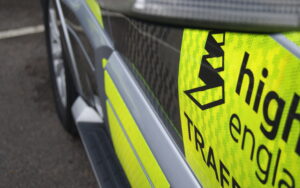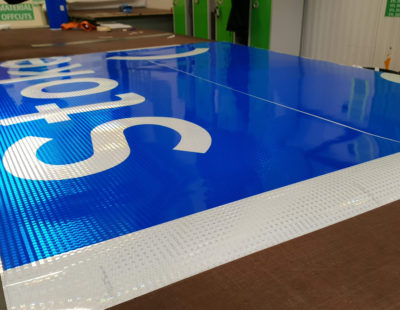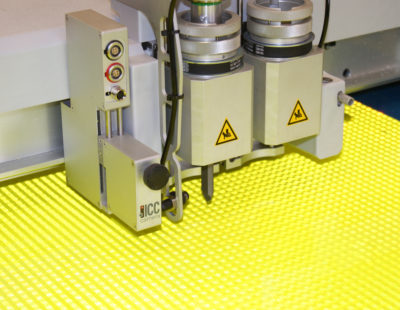Sometimes in the traffic and road safety industry, you might come across the term ‘retroreflective’. Describing the ability of a material to reflect the majority of light that hits it back to its source, retroreflectivity is critical for traffic sign construction. With the power to enhance the visibility of all signs even in dark and inclement conditions, retroreflective materials are integral elements of road safety.
Lakeside Group is a leading supplier of quality retroreflective products for permanent and temporary traffic signs. We know the power of these materials to improve safety for all road users, and are dedicated to providing local authorities and private landowners alike with the best technology on the market.
In this blog, we explain everything you need to know about retroreflectivity, the physics behind it, and why it’s critical to road safety.
What is retroreflectivity?
A retroreflective material reflects a significant proportion of the light that hits it back to the source. The prefix ‘retro’ means ‘backwards’, and this is precisely what differentiates it from standard reflectivity – more on that below!
A high quality retroreflective material will return around 60% of a directed light beam back to its source, which is why they are often utilised in traffic sign construction. Sign retroreflectivity is critical to road safety, enabling users to see and understand the information presented by traffic signs even during poor weather or at night. A factor which is increasingly important in countries, such as the UK, where the driving population is getting older.
There are several different grades of retroreflective materials available according to your specifications: engineering grade, high intensity, and micro prismatic. Explore our comprehensive overview here.
What is the difference between reflective & retroreflective?
Retroreflectivity is distinguished from reflectivity by the amount of light returned to its source. All surfaces are reflective to some degree – that’s how we are able to see them – but many do so inefficiently. Often, the light that hits a surface does so at an angle, meaning it bounces off the surface in multiple other directions too. Consequently, most of the light that hits the material is diffused rather than returned.
For applications that require high conspicuity like emergency service vehicle markings and traffic signs, it is necessary to use materials that are more efficient at returning light. These materials are retroreflective; that is, they send the majority of the light that hits them back to the source.
How do retroreflective materials work?
The way a retroreflective material works depends on its construction. Some materials consist of glass beads in front of a mirrored surface. These glass beads bend the light that enters the sign. The light then reflects off the mirrored surface and bends again as it exits the sign in direction of entry.
Some products on the market utilise micro prisms or even glass cubes instead of beads. These materials offer greater efficiency and are used where the need for conspicuity is even greater. Due to the faceted surface of the glass within the sign, the light changes direction multiple times before being sent back through the glass and returning to its source. This results in more light being returned and better overall traffic sign visibility.
A Beginner’s Guide to Reflective Sheeting for Traffic Signs >
Importance of traffic sign retroreflectivity
Ensuring traffic signs are highly conspicuous is vital for the safety of road users and pedestrians. Reduced visibility, depth, and hazard perception mean accidents at this time can be more likely. Clearly, retroreflective materials offer numerous benefits. Here are some of the most significant.
- – Better road comprehension – when road users and pedestrians can clearly make out the information displayed on traffic signs, they are less likely to be confused and more likely to continue their journeys in a safe and orderly fashion.
- – Advance warning – highly conspicuous traffic signs ensure all road users are aware well in advance of any warnings and hazards that may impact their journey, minimising potential panic.
- – Regulation adherence – there are strict regulations governing the materials used for traffic signs, and adhering to these is vital. Find out more in our guides to temporary and permanent traffic sign regulations!
- – Reduced cost & infrastructure – retroreflectivity means traffic signs don’t need to be directly lit to remain highly conspicuous, reducing the cost and infrastructure required and allowing signs to be more portable.
Established supplier of high quality retroreflective materials
Lakeside Group has more than 30 years’ experience in the traffic, cycle, and pedestrian safety industries, providing our clients with highly conspicuous retroreflective products that perform when it matters most.
If you’re looking for unrivalled durability for your permanent traffic signage, check out the below video to find out more about our winning combination of 15 year R3C micro prismatic sheeting, durable TrafficJet inks and OL-1200 dew-resistant overlay film.
If you have any questions about our range, feel free to contact a member of our friendly team.
Learn more: Air Gap vs Metallised Micro Prismatic Products – A Guide to Reflective Material Construction




